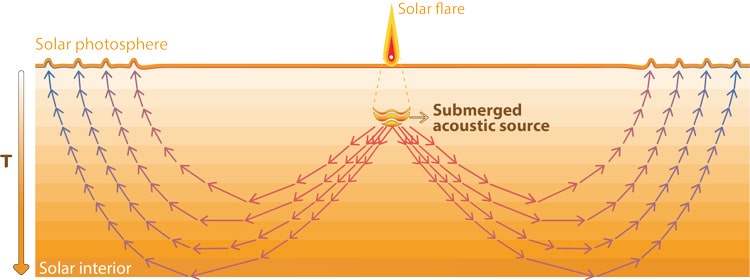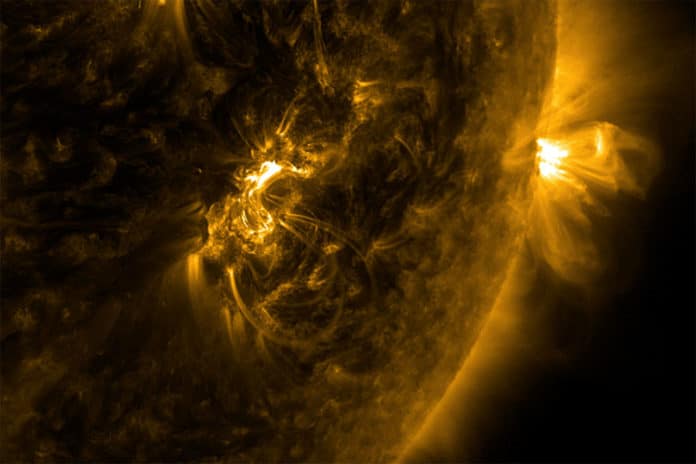Solar flares are an explosion of energy caused by tangling, crossing, or reorganizing magnetic field lines near sunspots. Solar flares release a lot of radiation into space. If a solar flare is very intense, the radiation it emits can interfere with our radio communications here on Earth.
Solar flares can also generate sunquakes- a quake that occurs on the Sun that releases impulsive acoustic waves that penetrate deep into the Sun’s interior.
However, the relation between solar flares and sunquakes remains mysterious. Still, a new study suggests that the acoustic transients and the resulting solar ripples can tell us more about the solar flare. According to scientists, it may help them forecast their size and severity.
The study was conducted by a team of physicists from the United States, Colombia, and Australia. The team found that the acoustic energy released from a flare in 2011 emanated from about 1,000 kilometers beneath the solar surface — the photosphere. It was far beneath the solar flare that triggered the quake.
For the study, the team used the helioseismic holography technique to analyze acoustic waves triggered by flares to probe their sources, much as seismic waves from megaquakes on Earth allow seismologists to locate their epicenters.
Co-author Juan Camilo Buitrago-Casas, a University of California, Berkeley, a doctoral student in physics from Colombia, said, “We can’t see the Sun’s inside directly. It is opaque to the photons that show us the Sun’s outer atmosphere, from where they can escape reaching our telescopes. The way we can know what happens inside of the Sun is via seismic waves that make ripples on the solar surface similar to those caused by earthquakes on our planet.”
“A big explosion, such as a flare, can inject a powerful acoustic pulse into the Sun, whose subsequent signature we can use to map its source in some details paper’s The big messper is that the source of at least some of this noise is deeply submerged. We are reporting the deepest source of acoustic waves so far known in the Sun.”
How sunquakes produce ripples on the Sun’s surface?
The acoustic explosions that cause sunquakes in some flares transmit acoustic waves in all directions, mainly downward. As the downward-voyaging waves move through areas of ever-increasing temperature, their ways are bent by refraction, thus heading back up to the surface, where they create ripples. The time between the explosion and the arrival of the ripples is around 20 minutes.

From NorthWest Research Associates in Boulder, Charles Lindsey said, “The ripples, then, are not just a surface phenomenon, but the surface signature of waves that have gone deep beneath the active region and then back up to the outlying surface in the next hour. Analyzing the surface ripples can pinpoint the source of the explosion.”
Juan Carlos Martínez Oliveros, a solar physics researcher at UC Berkeley’s Space Sciences Laboratory and a native of Colombia, said, “It has been widely supposed that the sources of the waves released by acoustically active flares are injected into the solar interior from above. What we are finding is the strong indication that some of the sources are far beneath the photosphere. It seems like the flares are the precursor, or trigger, to the acoustic transient released. There is something else happening inside the Sun that is generating at least some part of the seismic waves.”
“Using an analogy from medicine, what we (solar physicists) were doing before is like using X-rays to look at one snapshot of the interior of the Sun. Now, we are trying to do a CAT scan to view the solar interior in three dimensions.”
Lindsey said, “We have known about acoustic waves from flares for a little over 20 years now, and we have been imaging their sources horizontally since that time. But we have only recently discovered that some of those sources are submerged below the solar surface. This may help explain a great mystery: Some of these acoustic waves have emanated from locations that are devoid of local surface disturbances that we can directly see in electromagnetic radiation. We have wondered for a long time how this can happen.”
About half of the medium-sized solar flares that Buitrago-Casas and Martínez Oliveros have cataloged have been associated with sunquakes, showing that they commonly occur together. The team has since found other submerged sources associated with even weaker flares.
The discovery of submerged acoustic sources opens the question of whether there are instances of acoustic transients being released spontaneously, with no surface disturbance, or no flare, at all.
Martínez Oliveros said, “If sunquakes can be generated spontaneously in the Sun, this might lead us to a forecasting tool if the transient can come from the magnetic flux that has yet to break the Sun’s surface. We could then anticipate the inevitable subsequent emergence of that magnetic flux. We may even forecast some details about how large an active region is about to appear and what type — even, possibly, what kinds of flares — it might produce. This is a long shot, but well worth looking into.”
Journal References
- Charles Lindsey et al. Submerged Sources of Transient Acoustic Emission from Solar Flares. DOI: 10.3847/2041-8213/abad2a
- Angel D. Martínez et al. Ultra-impulsive Solar Flare Seismology. DOI: 10.3847/2041-8213/ab9173
